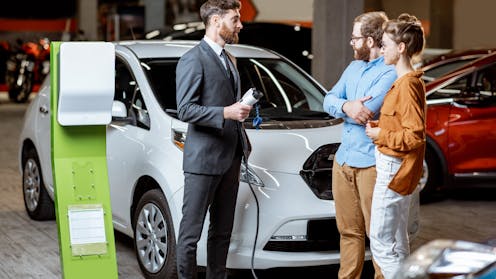Will UK’s 10% discount get more people buying electric cars? The evidence doesn’t look good
The UK government is offering a 10% taxpayer-funded discount on new plug-in cars that cost less than £37,000. It’s an attempt to re-energise the currently flatlining market for new electric vehicles (EVs) in the UK – but there are reasons for people’s reluctance that a price cut alone won’t solve.
The £37k price limit excludes all new Tesla, BMW and Mercedes-Benz cars – with Tesla still topping EV sales in the UK despite the recent backlash against its owner, Elon Musk. Many Chinese imports are also excluded as they fail to meet the UK’s sustainability criteria, primarily due to high coal use in the generation of electricity that powers Chinese EV factories – although these models will qualify for a smaller discount.
The UK government has framed its subsidy as an effort to make EVs easier and cheaper to own than petrol cars. This is something the car industry has been lobbying hard for, since it will be barred from offering new petrol and diesel cars for sale in the UK after 2030. Meanwhile, carmakers selling in the UK have to meet compulsory yearly sales targets for EVs.
While the UK is obliged by legislation to accelerate its transition to net zero, as a senior researcher of the switch to electric transport, I believe the new EV subsidy is a reactive measure which neglects more fundamental obstacles to wider EV adoption, such as the UK’s inadequate provision of chargers. It also fails to tackle entrenched misconceptions about these vehicles.
Why price cuts fall short
In a study I conducted with 2,000 car drivers in the UK in 2024, 50% claimed cost was their major impediment to buying an EV, even though EVs sometimes undercut similar petrol cars. The latter are universally increasing in price due to the complexity of designing parts that meet emissions targets.
Perceptions often lag reality, however, and the sense that EVs are always the more expensive option is why I found only 4% of drivers were “very likely” to buy an EV next.
The fleet market (vehicles purchased by companies for lease or business use) is where incentives like the one the UK government is offering have worked well. In research I published with colleagues in 2025, we assessed EV fleet adoption by businesses in the east of England.
We found tax incentives that encourage businesses to add EVs to their fleets – particularly if they offer them to company car drivers – are extremely effective, as they offer a joint benefit for both company and driver.
Businesses concerned with the cost of acquiring and maintaining their fleets appreciate that EVs require less maintenance. Company car drivers also prefer driving EVs once they spend some time with them, research suggests.
In our research, 80% of EV sales to company car fleets were attributed to tangible financial advantages such as these tax incentives. The rest were put down to the greener public image they cultivate for businesses. The popularity of EVs as company cars is apparent in market data: only one in ten new EV sales are to private buyers.
Returning to my study of private drivers, 50% of those who opted against buying an EV cited high upfront costs, while 40% highlighted inadequate charging options. This suggests purchase incentives like the 10% discount will not fully address the reluctance of private buyers.
The UK government has promised to invest £63 million by 2030 in building 25,000-50,000 new chargers (some of which are earmarked for local authority and NHS use). But as an EV driver of over 12 years, I think the UK’s public charging network is a mess.
The promised investment will still see the government fall short of its target of 300,000 chargers by 2030. What’s more, because of the 20% VAT rate on public charging, EV owners can pay up to ten times more for charging on the road than at home. This makes EVs, which the public already see as more expensive, actually more expensive to fuel than a small, economical diesel.
Lessons from abroad
The UK has so far failed to comprehensively deal with poor public perceptions of EVs.
Governments can get this right, though. Look at Norway, where 96% of new car sales are electric. This is thanks to consistent policies since the 1990s aimed at changing perceptions – and not merely the use of blunt instruments such as taxpayer-funded discounts.
A 2022 study of Norwegian EV owners highlighted how economic perks such as exemption from the 25% VAT rate on EV sales initially drove uptake. But sustaining this involved tackling public concerns about the limited range of EVs and the availability of public chargers.
You only need to visit Norway to see how: retail parks now have upwards of 30 EV chargers – and increasingly, no petrol pumps – compared with maybe two-to-four chargers in UK retail parks. This has led to 80% of Norwegian EV owners reporting higher satisfaction compared with owners of combustion-engine vehicles.
Norway’s public charging network is more advanced than the UK’s.
Baloncici/Shutterstock
My survey results suggest perceptions of cost and practicality will lag reality until policies bridge the gap. This explains the UK’s stubborn 50% cost-barrier fixation, despite competitive pricing and a history of subsidies.
In contrast, Norway has successfully transformed public perceptions of EVs from “expensive novelties” to “smart, cost-effective and practical” by not stopping at price subsidies. By implementing strategic policies such as ensuring charging stations every 50km along major routes and capping charging costs, it avoided the political disagreements that have hindered EV adoption in the UK.
The UK’s efforts, such as discontinuing a purchase grant in 2022 and only partially reinstating it in 2025, have lacked the steady, comprehensive approach that drove Norway’s EV success.
The UK is in a tricky position. Sales mandates and the 2030 petrol and diesel car ban are pushing manufacturers towards selling EVs – but the public is buying only a tiny proportion of the new EVs in showrooms. What’s worse, people are still buying petrol cars in droves: the UK’s best-selling car 4.5 years away from the ban is the Nissan Qashqai – a model not available in electric.
So, while discounts on EVs will help, they will not significantly raise adoption because they treat symptoms, such as perceived upfront costs, rather than causes, such as lack of infrastructure, high charging costs, and a lack of cheaper used EVs that buyers feel they can trust.
To re-energise the EV market, the UK government should also extend the more-generous tax cuts that businesses receive on fleet purchases to private buyers, cap public charging costs to ensure price parity when driving an EV, and also level VAT on charging across the board.
Don’t have time to read about climate change as much as you’d like?
Get a weekly roundup in your inbox instead. Every Wednesday, The Conversation’s environment editor writes Imagine, a short email that goes a little deeper into just one climate issue. Join the 45,000+ readers who’ve subscribed so far.
Tom Stacey receives funding from ERDF for the Eastern New Energy Project.



